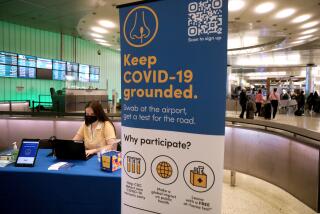Just How Sick Is Too Sick to Fly?
- Share via
As airline passengers listen to coughing and sneezing around them, they worry about catching those illnesses while flying. Many have concerns, too, about contracting more serious diseases such as tuberculosis, meningitis and plague.
The crucial question becomes, “How sick is too sick to fly?” The answer is governed by federal regulations and individual policies of the airlines. Under the Air Carrier Access Act, a law created to prevent the spread of communicable diseases or infections, airlines may prohibit travel of passengers with such diseases. The act generally stops short of describing specific diseases, permitting individual airlines to compose a list, according to Bill Mosley, spokesman for the U.S. Department of Transportation.
But in a clarification of these regulations, published Nov. 1 in the Federal Register, a government publication that prints regulations issued by federal agencies, the common cold was singled out as an example of a condition not serious enough to warrant restrictions.
Even so, healthy passengers seated next to those with colds or coughs do have recourse, at least theoretically. They can ask to be relocated within the plane, according to airline officials, who said they do so whenever possible. But on full planes, it is often not an option.
Sometimes, the sick passenger is moved away from healthy ones. Beyond those generalities, policies on sick passengers vary.
At Northwest Airlines, for example, “We do have specific instructions about passengers we won’t accept,” said spokeswoman Kathy Peach. Passengers with chickenpox in the infectious stage, measles, mumps and infectious tuberculosis are on the list.
At Air New Zealand, “We ask that you not fly if you have a physical, medical or mental condition that requires immediate medical attention,” said spokesman James Boyd. Medical clearance might be required for other conditions.
At Southwest Airlines, “We don’t have a set policy on who is too sick to fly,” said spokeswoman Linda Rutherford. “Basically what we do is leave that up to our customer service agents, who see every single customer check in. Obviously, with a passenger who looks visibly ill, who might be getting sick, who is perspiring heavily, we would ask if we could do something.” That could entail a refund or a new booking.
At other airlines, too, customer service agents or other employees who first come in contact with passengers are trained to be aware of symptoms of serious illnesses, spokespersons said.
At Air New Zealand, for instance, check-in personnel are trained to be on the lookout for seriously ill travelers, Boyd said.
At Northwest, gate agents keep an eye out, Peach said, for passengers who look seriously ill. Depending on the situation, the gate agent may contact complaint resolution officials who may contact a physician in the community to help determine whether the passenger is healthy enough to fly.
The surveillance continues aloft. Recently, a British Airways flight from London to Philadelphia was isolated when it landed, Lampl said, because typhoid fever was suspected in one passenger. (Public health officials called to the scene later determined that it was not typhoid.)
Under federal regulations, a sick traveler may be asked by the airline to provide a medical certificate stating fitness to travel.
And if a sick traveler is turned away, federal regulations stipulate that the carrier permit the passenger to travel later--up to 90 days after the original illness--at the original fare, or to provide a refund.
Soon, the air aloft might be less friendly to circulating germs. The Aviation Clean Air Act is expected to be reintroduced in the U.S. House and Senate by mid-March, said Brett Heimov, a legislative assistant in the office of Rep. Jerrold Nadler (D-NY). “The bill asks for 100% fresh air circulation [within the airplane cabin] with no recirculation,” Heimov said.
The Healthy Traveler appears the second and fourth week of every month.
More to Read
Sign up for The Wild
We’ll help you find the best places to hike, bike and run, as well as the perfect silent spots for meditation and yoga.
You may occasionally receive promotional content from the Los Angeles Times.






